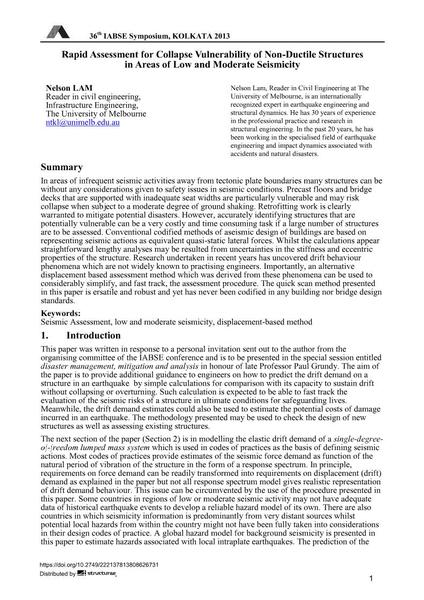Rapid Assessment for Collapse Vulnerability of Non-Ductile Structures in Areas of Low and Moderate Seismicity

|
|
|||||||||||
Bibliografische Angaben
| Autor(en): |
Nelson Lam
|
||||
|---|---|---|---|---|---|
| Medium: | Tagungsbeitrag | ||||
| Sprache(n): | Englisch | ||||
| Tagung: | IABSE Symposium: Long Span Bridges and Roofs - Development, Design and Implementation, Kolkata, India, 24-27 September 2013 | ||||
| Veröffentlicht in: | IABSE Symposium Kolkata 2013 | ||||
|
|||||
| Seite(n): | 1-12 | ||||
| Anzahl der Seiten (im PDF): | 12 | ||||
| Jahr: | 2013 | ||||
| DOI: | 10.2749/222137813808626731 | ||||
| Abstrakt: |
In areas of infrequent seismic activities away from tectonic plate boundaries many structures can be without any considerations given to safety issues in seismic conditions. Precast floors and bridge decks that are supported with inadequate seat widths are particularly vulnerable and may risk collapse when subject to a moderate degree of ground shaking. Retrofitting work is clearly warranted to mitigate potential disasters. However, accurately identifying structures that are potentially vulnerable can be a very costly and time consuming task if a large number of structures are to be assessed. Conventional codified methods of aseismic design of buildings are based on representing seismic actions as equivalent quasi-static lateral forces. Whilst the calculations appear straightforward lengthy analyses may be resulted from uncertainties in the stiffness and eccentric properties of the structure. Research undertaken in recent years has uncovered drift behaviour phenomena which are not widely known to practising engineers. Importantly, an alternative displacement based assessment method which was derived from these phenomena can be used to considerably simplify, and fast track, the assessment procedure. The quick scan method presented in this paper is ersatile and robust and yet has never been codified in any building nor bridge design standards. |
||||
